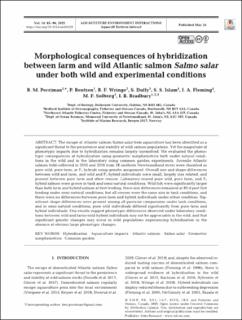| dc.contributor.author | Perriman, B.M. | |
| dc.contributor.author | Bentzen, P. | |
| dc.contributor.author | Wringe, B.F. | |
| dc.contributor.author | Duffy, S. | |
| dc.contributor.author | Islam, S.S. | |
| dc.contributor.author | Fleming, I.A. | |
| dc.contributor.author | Solberg, Monica Favnebøe | |
| dc.contributor.author | Bradbury, I.R. | |
| dc.date.accessioned | 2022-10-31T08:42:07Z | |
| dc.date.available | 2022-10-31T08:42:07Z | |
| dc.date.created | 2022-10-20T11:03:56Z | |
| dc.date.issued | 2022 | |
| dc.identifier.citation | Aquaculture Environment Interactions. 2022, 14 85-96. | en_US |
| dc.identifier.issn | 1869-215X | |
| dc.identifier.uri | https://hdl.handle.net/11250/3029007 | |
| dc.description.abstract | The escape of Atlantic salmon Salmo salar from aquaculture has been identified as a significant threat to the persistence and stability of wild salmon populations. Yet the magnitude of phenotypic impacts due to hybridization remains largely unresolved. We evaluated the phenotypic consequences of hybridization using geometric morphometrics both under natural conditions in the wild and in the laboratory using common garden experiments. Juvenile Atlantic salmon field-collected in 2015 and 2016 from 18 southern Newfoundland rivers were classified as pure wild, pure farm, or F1 hybrids using genetic assignment. Overall size and shape differences between wild and farm, and wild and F1 hybrid individuals were small, largely size related, and present between pure farm and other crosses. Laboratory-reared pure wild, pure farm, and F1 hybrid salmon were grown in tank and semi-natural conditions. Wild fish were significantly larger than both farm and hybrid salmon at first feeding; these size differences remained at 80 d post first feeding under semi-natural conditions, but all crosses were the same size in tank conditions, and there were no differences between pure farm and hybrid individuals under either condition. Significant shape differences were present among all pairwise comparisons under tank conditions, and in semi-natural conditions, pure wild individuals differed significantly from pure farm and hybrid individuals. Our results suggest phenotypic differences observed under laboratory conditions between wild and farm×wild hybrid individuals may not be appreciable in the wild, and that significant genetic changes may occur in wild populations experiencing hybridization in the absence of obvious large phenotypic changes. | en_US |
| dc.language.iso | eng | en_US |
| dc.title | Morphological consequences of hybridization between farm and wild Atlantic salmon Salmo salar under both wild and experimental conditions | en_US |
| dc.title.alternative | Morphological consequences of hybridization between farm and wild Atlantic salmon Salmo salar under both wild and experimental conditions | en_US |
| dc.type | Peer reviewed | en_US |
| dc.type | Journal article | en_US |
| dc.description.version | publishedVersion | en_US |
| dc.source.pagenumber | 85-96 | en_US |
| dc.source.volume | 14 | en_US |
| dc.source.journal | Aquaculture Environment Interactions | en_US |
| dc.identifier.doi | 10.3354/aei00429 | |
| dc.identifier.cristin | 2063165 | |
| dc.relation.project | Norges forskningsråd: 310599 | en_US |
| cristin.ispublished | true | |
| cristin.fulltext | original | |
| cristin.qualitycode | 1 | |
